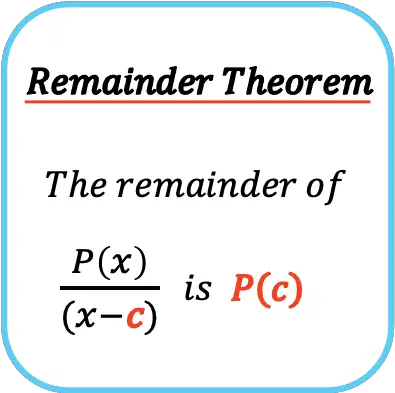Here you will find what the remainder theorem is and how to use it in polynomials. You will also see examples and, in addition, exercises solved step by step on the remainder theorem.
Table of Contents
What is the remainder theorem?
The definition of the remainder theorem is as follows:
The remainder theorem states that the remainder of the division of any polynomial P(x) by another lineal factor in the form (x-c) is equal to the evaluation of the polynomial P(x) at the value x=c, that is, the remainder of the division P(x)÷(x-c) is P(c).

As you already know, there are 4 terms involved in a division:
– Dividend: the term that is divided.
– Divisor: the term that divides the dividend.
– Quotient: the result of dividing the dividend by the divisor.
– Remainder: the term “left over” after dividing the two polynomials.
Using the result of a division, any number can be decomposed into the product of the divisor and the quotient plus the remainder:
Likewise, we can transform a polynomial using the result of a polynomial division:
Where P(x) is the dividend, d(x) the divisor, Q(x) the quotient and R(x) the remainder of the polynomial division.
So, if the dividend is a binomial in the form x-c, the equation is:
And if we evaluate the polynomial at the value of c, we obtain:
Where R(c) is the remainder of the polynomial division.
Thus, the formula of the polynomial remainder theorem is proven.
Example of the remainder theorem
Once we have seen what the remainder theorem means, let’s see an example of its application:
- Calculate the remainder of the division of the following two polynomials:
To find the remainder of the polynomial division we can use the remainder theorem, because in this case the divisor polynomial is in the form (x-c), that is, it is of first degree, the coefficient of the variable x is 1 and has a constant term.
Then, we apply the remainder theorem, which says that the remainder of a division like this is equal to the evaluation of the polynomial of the dividend at the constant term but changed sign, that is, P(1).

Therefore, to find the remainder of the division we have to evaluate the polynomial at x=1:
So the remainder of the division of the polynomials is 2.
We can also check the remainder by dividing the polynomials using synthetic division with remainder:

➤ Note: we can also use the polynomial long division to find the remainder.
As you can see, it is much faster and easier to determine the remainder of a division of a polynomial by a linear polynomial using the remainder theorem than dividing the polynomials, since much less calculations are done.
Remainder and factor theorem
From the remainder theorem and the definition of root (or zero) of a polynomial we can deduce the factor theorem.
The factor theorem says that a polynomial P(x) is divisible by another polynomial in the form (x-c) if, and only if, P(c)=0. And, in that case, c is a root (or zero) of the polynomial P(x).
Furthermore, according to the remainder theorem, this means that if a polynomial is divisible by another polynomial, the remainder of that division is zero, since P(c)=0.
For example, if we have the following polynomial:
This polynomial is divisible by the binomial (x-2) because P(2)=0:
Since P(2)=0, x=2 is a root of the polynomial.
Moreover, we can know thanks to the remainder theorem that the remainder of the polynomial division is equal to 0.
Practice problems on the remainder theorem
To understand better the remainder theorem, we leave you some practice problems. You can try to do the problem on your own and then check whether you have done it correctly.
Problem 1
Using the remainder theorem, find the remainder of the polynomial division , being the polynomials involved in the operation:
The divisor polynomial is composed of only a first-degree term and a constant term, and furthermore, the coefficient of the first-degree term is 1. Therefore, we can use the remainder theorem.
To apply the remainder theorem, we simply have to evaluate the dividend polynomial at the constant term of the divisor polynomial changed sign, in other words, we have to calculate P(2).
So the remainder of the division of the two polynomials is 21 .
Problem 2
Given the polynomial find the remainder that is obtained when dividing
by each of the following polynomials:
Since all dividing polynomials meet the conditions of the remainder theorem, we can use the theorem to determine the remainder of each division:
Problem 3
Calculate the unknown so that the remainder of the polynomial division
is 3.
In this particular case, the divisor polynomial is composed of a monomial of first degree and a constant term, and the coefficient of the first degree monomial is 1. So we can use the remainder theorem.
And to use the remainder theorem, we simply have to evaluate the dividend polynomial at the constant term of the divisor polynomial changed sign:
The problem tells us that the remainder must be equal to three, therefore, we have to set the remainder equal to 3:
And finally, we solve the equation:
Problem 4
Determine using the factor and the remainder theorem whether the polynomial is divisible by the polynomial
For the polynomial to be divisible by the polynomial
, the division of the two polynomials must be exact and, therefore, the remainder must be zero.
So, since the divisor polynomial is from the factor theorem and the remainder theorem we know that the polynomial
will be divisible by the polynomial
if
So we have to see if this equality holds:
Indeed, the remainder of the division is equal to 0, so the polynomial
is divisible by the polynomial